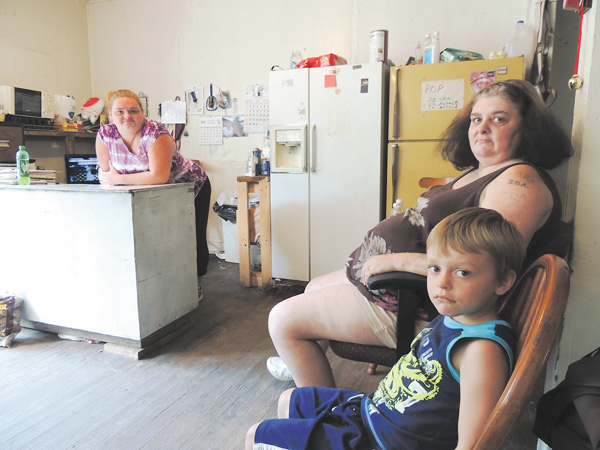As economic security declines, American dream eludes many


Renee Adams, left, poses with her mother, Irene Salyers, and son Joseph, 4, at their produce stand in Council, Va. Four out of five U.S. adults struggle with joblessness, near poverty or reliance on welfare for at least parts of their lives, a sign of deteriorating economic security and a vanishing American dream amid rising incidences of hardship among whites.
Associated Press
WASHINGTON
Four out of five U.S. adults struggle with joblessness, near poverty or reliance on welfare for at least parts of their lives, a sign of deteriorating economic security and an elusive American dream.
Survey data exclusive to The Associated Press point to an increasingly globalized U.S. economy, the widening gap between rich and poor and loss of good- paying manufacturing jobs as reasons for the trend.
The findings come as President Barack Obama tries to renew his administration’s emphasis on the economy, saying recently that his highest priority is to “rebuild ladders of opportunity” and reverse income inequality.
Hardship is particularly on the rise among whites, based on several measures. Pessimism among that racial group about their families’ economic futures has climbed to the highest point since at least 1987. In the most recent AP-GfK poll, 63 percent of whites called the economy “poor.”
“I think it’s going to get worse,” said Irene Salyers, 52, of Buchanan County, Va., a declining coal region in Appalachia. Married and divorced three times, Salyers helps run a fruit and vegetable stand with her boyfriend, but it doesn’t generate much income. They live mostly off government disability checks.
“If you do try to go apply for a job, they’re not hiring people, and they’re not paying that much to even go to work,” she said.
While racial and ethnic minorities are more likely to live in poverty, race disparities in the poverty rate have narrowed substantially since the 1970s, census data show. Economic insecurity among whites also is more pervasive than is shown in government data, engulfing more than 76 percent of white adults by the time they turn 60, according to a new economic gauge being published next year by the Oxford University Press.
The gauge defines “economic insecurity” as experiencing unemployment at some point in their working lives, or a year or more of reliance on government aid such as food stamps or income below 150 percent of the poverty line. Measured across all races, the risk of economic insecurity rises to 79 percent.
“It’s time that America comes to understand that many of the nation’s biggest disparities, from education and life expectancy to poverty, are increasingly due to economic class position,” said William J. Wilson, a Harvard professor who specializes in race and poverty.
He noted that despite continuing economic difficulties, minorities have more optimism about the future after Obama’s election, while struggling whites do not. “There is the real possibility that white alienation will increase if steps are not taken to highlight and address inequality on a broad front,” Wilson said.
Sometimes termed “the invisible poor” by demographers, lower-income whites are generally dispersed in suburbs as well as small rural towns, where more than 60 percent of the poor are white. Concentrated in Appalachia in the East, they are numerous in the industrial Midwest and spread across America’s heartland.
More than 19 million whites fall below the poverty line of $23,021 for a family of four, accounting for more than 41 percent of the nation’s destitute, nearly double the number of poor blacks.
 43
43
